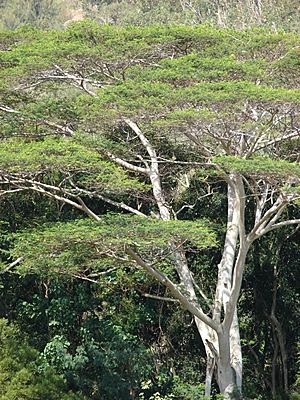Falcataria moluccana facts for kids
Quick facts for kids Moluccan albizia |
|
|---|---|
 |
|
| Specimen at Waiehu, Maui | |
| Scientific classification | |
| Kingdom: | |
| (unranked): | |
| (unranked): | |
| (unranked): | |
| Order: | |
| Family: | |
| Subfamily: | |
| (unranked): | |
| Genus: |
Falcataria
|
| Species: |
F. moluccana
|
| Binomial name | |
| Falcataria moluccana (Miq.) Barneby & J.W.Grimes
|
|
| Synonyms | |
|
|
The Moluccan albizia (scientific name: Falcataria moluccana) is a type of tree that grows very quickly. It belongs to the legume family, called Fabaceae. This tree originally comes from places like the Maluku Islands, New Guinea Island, the Bismarck Archipelago in Papua New Guinea, and the Solomon Islands.
People grow the Moluccan albizia in many South Asian and Southeast Asian countries to use its wood. However, in places like Hawaii, American Samoa, and other islands in the Pacific and Indian Oceans, it is considered an invasive plant. This means it spreads easily and can take over natural areas. In the wild, these trees can grow to be about 30 meters (about 100 feet) tall. They have a very large trunk and a wide, open top.
Contents
What is the Moluccan Albizia?
The Moluccan albizia is known by many names around the world. This is because it is grown in many warm, wet places.
Some of its common names include:
- Albizia (in Hawaii)
- Sengon (in Java, Indonesia)
- Salawaku (in the Maluku Islands)
- Jeungjing (also in Indonesia)
- Ai-samtuco (in Tetun, Timor-Leste)
- Batai (in Malaysia)
- Kerosin tree (in Pohnpei)
- Sau, Moluccan sau, and Falcata (in the Philippines)
- Tamaligi (in Samoa)
Tree Features and Appearance
The Moluccan albizia has several unique features. These help people identify the tree.
- Leaves: The leaves are made up of many small leaflets. They are arranged in a double feather-like pattern.
- Flowers: The flowers are small and a creamy white color. They have a light, pleasant smell.
- Fruits: The tree produces pods as fruits. These pods fall off the tree when they are fully grown.
- Bark: The bark of the tree is smooth. It usually has a light or white color.
- Wood: The wood is light tan. It has long, strong fibers. The wood is also quite light, weighing about 280 kilograms per cubic meter.
This tree has become invasive in many forests. This is especially true in Hawaii and other Pacific islands, like New Caledonia. It can grow quickly and outcompete native plants.
How is the Moluccan Albizia Used?
The Moluccan albizia is used for many different things. Both modern industries and traditional communities use this tree.
- Commercial Uses: The soft wood from the Moluccan albizia is used to make many products. These include match-sticks, chopsticks, and wooden boxes for shipping. It is also used to make pallets, which are flat structures for moving goods. The wood pulp is used to make paper. More and more, the tree is also used for making plywood and other wood products that have thin layers of wood.
- Traditional Uses: In some places, like Timor-Leste, entire tree trunks are carved out to make large canoes for traveling on the sea. The wood is also widely used as firewood for cooking and heating.
- Agroforestry: This tree is often planted alongside other crops. For example, it is grown as a shade tree for coffee plants. It is also planted with Eucalyptus trees to help add nitrogen to the soil. This makes the soil healthier for other plants. In Indonesia and Timor-Leste, it is grown with pineapples and other crops.
Insects and the Moluccan Albizia
Many different insects interact with the Moluccan albizia tree. Some insects eat the tree's leaves or wood.
- In Hawaii, a caterpillar called the Hawaiian koa looper (Scotorythra paludicola) has been seen eating the leaves of the Moluccan albizia. These caterpillars can grow up on this tree, even though their usual food is the native Acacia koa tree.
- In Borneo, several types of moths feed on the Moluccan albizia. These include Lymantria brunneiplaga, Hypochrosis cryptopyrrhata, Erygia spissa, and Hypopyra pudens.
- Other insects found eating F. moluccana in the wider Indomalayan region include:
- Butterflies like Charaxes bernardus, Eurema blanda, and Eurema hecabe. The caterpillars of the last two species can be pests for young trees.
- The longhorn beetle Xystrocera festiva. Large groups of its larvae can feed under the bark. This can sometimes kill trees in plantations.
The wood of the Moluccan albizia can also be damaged by termites.
- A type of drywood termite, Cryptotermes cynocephalus, has been found to attack the wood.
- The subterranean termite Coptotermes formosanus also eats this tree's wood. These termites can cause significant damage.
Diseases Affecting the Tree
Like all living things, the Moluccan albizia can get diseases.
- The main disease affecting this tree is caused by a fungus called Uromycladium falcatarium. Another similar fungus, Uromycladium tepperianum, also affects it. Both of these fungi cause "gall rust," which creates abnormal growths or swellings on the tree. These diseases can severely harm the tree at any stage of its growth.
- Two types of bacteria, Streptomyces asiaticus and S. cangkringensis, have been found in the soil around the tree's roots in Indonesia. While some Streptomyces species can cause plant diseases, it is not clear if these two specific types harm the Moluccan albizia.
Gallery
Images for kids













